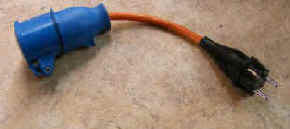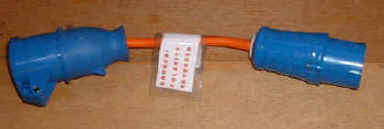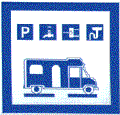CAMPSITES
There are all types of campsites abroad ranging
from luxury spa resorts to basic fields and a range of site fees to match.
We have found that overnight site fees are
rarely charged at an inclusive rate (Forfait, Pauschalpreis) unless you are using a low season discount
scheme such as ACSI Camping Card or Camping Cheques, and often you are charged
for the pitch (emplacement), for the vehicle (motorhome or car plus caravan) and
per person. In some areas a daily tourist tax (Tax de Sejour) of a few
cents to maybe €1 per person is added to the bill.
At the larger sites it is usual to pay the bill when you leave which is ideal if
you are not sure how long you are going to stay and we often book in initially
for one night but stay for a few more
In France there are many campsites that are
municipal i.e. run by the local council. These can be top rate four star
sites down to a basic one star site. The ratings are based on the number and
types of
amenities available not the quality of them! Often in small towns they are part
of the local stadium and may not have permanent staff with the Reception office
(Bureau, Accuiel)
only open for a couple of hours in the evening and morning or the warden (Guardienne)
may call round to campers in the evening to collect the fee so it is useful to
have plenty of small change. Usually receipts are given and there may be a
considerable amount of form filling either by hand or on a computer screen (we
have been asked for make and colour of our motorhome as well as registration
number) This especially
applies to one and two star sites.
We have found in Germany, Austria and Italy
many campsites to be mainly static caravans - often old tourers with lots of
wooden and canvas extensions, with just a few touring pitches sometimes among
the statics so not so attractive for lounging around.
Camping Card International CCI (previously
called a camping carnet) is an essential item to have as it provides third party
insurance whilst on a campsite and sometimes a small discount on the fee. It can
be obtained from the Caravan Club or Camping & Caravanning Club in the UK
before you set off for about £4.75 and is valid for one year. As it contains
your place of birth and passport number it is usually shown when booking in and
may be retained at the campsite office instead of your passport (Don't forget to
collect it before you leave the site!) We have never handed over our passports
at a campsite having seen the casual way they are sometimes stored.
This card
is not to be confused with the ACSI Camping
Card which is an excellent value discount card for reduced prices low season camping throughout
Europe. Similar schemes are available such as Camping Cheques.

Camping Card International ACSI
Camping Card
Pitches may be marked out with hedges
and can vary in size to very large with individual water taps and electricity
connection points to extremely cramped with no 20 foot rule as found in the UK.
Sometimes tents and caravans are in different areas but we have woken up to find
a tent being pitched a metre away from us. A disadvantage with marked pitches is
that the grass can be worn out or muddy and gravel or stone hard standings are
not so common abroad.
Electric hookups (EDF, Branchement, Stromm) may be charged for separately and is often offered at various prices depending on the current rating (amps)
available and can be quite expensive for 10A or
above. 3 Amps is enough for our fridge ( 120W) and Truma water heater (450W). You may find that the
site owner
comes along and connects your hookup
point sometimes in a locked cabinet. Also meters are becoming more common so be
aware if you want an early get-away in the morning as there may be some delay in
getting disconnected and paying your bill. Hookup points are
becoming more standardised on the EEC blue three pin connector but on older
sites the European two pin connector is used with a third earth pin in the
socket.


Adaptor for old style European two pin
plug
Reverse polarity convertor
Due to differences in the electrical wiring systems between Europe and
the UK the polarity of the connection i.e. Live - brown and Neutral - blue
wires may be reversed. It is advisable to check this using a polarity/earth
checking device which is plugged in once the connection is made to indicate by
various combinations of three neon lamps if there is reversed polarity or an
earth fault. It is easily corrected by using a short change-over lead to fit in
the cable. These can be obtained from Caravan dealers if you are not confident
with making up your own lead.
AIRES, STELLPLATZ and AREE DI SOSTA
WARNING staying at aires and rest places on motorways in Europe is not advised
due to high incidence of break-ins and thefts from vehicles especially as an
overnight stop but even leaving your vehicle unattended at any time is not
recommended. Suitable parking can usually be found in a small town or village near the
motorway.
Aires are specifically signposted places which provide an official parking place
for motorhomes, usually (but not always) allowing overnight stays and mostly
providing a service point known in France as a borne and Sani-station in
Germany, where you can obtain fresh drinking water, dispose of grey water and
empty the toilet cassette.

There is usually a sign indicating the charges and the arrangements for paying.
Sometimes everything is free. At others there is an overnight charge payable at
a ticket machine or collected by a local guardien who will call around in the
evening and should issue an official receipt. We have even had to find the town
hall (Mairie) to go and pay in the low season.
Payment for the services for a set amount of
water or for a short time eg ten minutes may be by coins, a token or jeton
obtained from a dispenser, a local nearby shop or bar and even by credit or
debit card. Some bornes provide electric hookup points for maybe one hour. We
have never bothered to use them although on rare occasions a free electricity
supply is provided or is included in the overnight charge.
There are thousands of aires in France and
stellplatz in Germany and hundreds of Aree di Sosta in Italy but only in few in
other European countries. Guidebooks are available for each country and their
locations as satnav POI files can be downloaded from various websites (see the links
page)
We have found these overnight stopping places
to be ideal although there are a few where we haven't been happy with either due
to their location eg an dubious part of a town or very remote places where there
are no other motorhomes parked On the other hand some are very popular and it
may be necessary to arrive mid afternoon to get a pitch. As you can see from the
pages listing aires we have visited they can vary a great deal from a bit of
rough ground to a cramped parking place with marked bays or a pleasant laid out
area with grass and room to sit outside. Some aires listed are inside or just
outside campsites and we have found that it is occasionally almost the same
price or cheaaper to use the campsite where you will have more space.
Most aires are intended as overnight stops so
you cannot reserve your pitch and the length of stay may be limited to 24, 48 or
72 hours although we have come across motorhomes that have obviously been
installed on an aire for a long time or some where pitches have been taken over
by travellers. You will often see the sign "Nomads interdit"
(travellers forbidden) in France especially near large towns and cities.
|